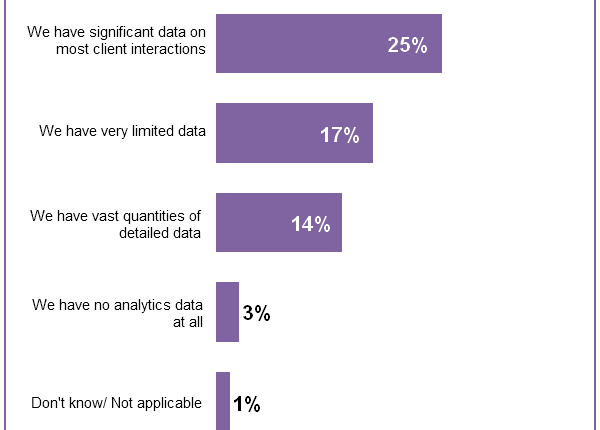The huge benefit of optimization and testing is to have your customers tell you what is most effective – which headline, which offer, even which value proposition – with their real-world actions during actual purchase decisions.
Of course, for this to work, you must be able to listen to what your customers are telling you through their actions.
In a world where “big data” is a big buzzword, many marketers might take this ability for granted. However, in the MarketingSherpa 2013 Marketing Analytics Benchmark Report, 20% of marketers told us they have very limited or no data …
Q: How much analytics data does your organization collect?
A full 40% of marketers only have “an average amount of data,” which does not sound like an overwhelming vote of confidence they have the information they need to intelligently plan, and execute, tests that will help them learn more about their customers.
As you review your analytics capabilities and plan for future improvements, Andrew Wise, VP of Global Sales, Prospectvision, offered a series of questions to help guide your efforts:
- How many discrete marketing tools are you using?
- How many channels (and sub-channels) are you juggling?
- How are you reconciling the data you get back from multiple activities?
- Do you know which campaigns are working? For which segments of your database?
- Can you watch a prospect move through stages of sales-readiness? Can you map your marketing actions to those stages?
- Can your sales team see what you see? In real time?
To the list, I would add one last crucial question …
What do you really need to know about your customers?
You can test and measure a limitless amount of behaviors. Some organizations suffer from this very problem: too much information and not enough knowledge.
So if you find yourself among the 20% who are data impoverished, use it to your advantage. Start from scratch and focus on the information that is really going to help you move the needle by understanding what your customers really want, and delivering on it, instead of getting stuck in analysis paralysis with endless reports.
Industry statistics, at large, can help you narrow your focus. Let’s take an extreme example …
“Social media is one of the key information sources that shoppers access on their phones,” said Robert Levy, President and CEO, BrandSpark International. “Six in 10 shoppers told us they trust social network peer recommendations and they are ready to access reviews on their mobile device. In fact, a third of the average smartphone owner’s total social networking time happens on their phone.”
Given this information, if you have a consumer product aimed at a young, affluent demographic who frequently uses social media, smartphone metrics and testing might be an important element of your analytics program.
However, if you have an older demographic who is less likely to use social media, mobile analytics, while a hot top, is less likely to be a necessary focus for you.
Related Resources:
Measuring What Matters: How simplifying your metrics can increase Marketing ROI by up to 75%
Marketing Analytics: 4 techniques to discuss with your data analysts
Marketing Optimization: 10 resources to help your online testing efforts





I love the point that we have plenty of information but not enough knowledge—great perspective on where to start picking up the slack in a firm’s marketing innovation.